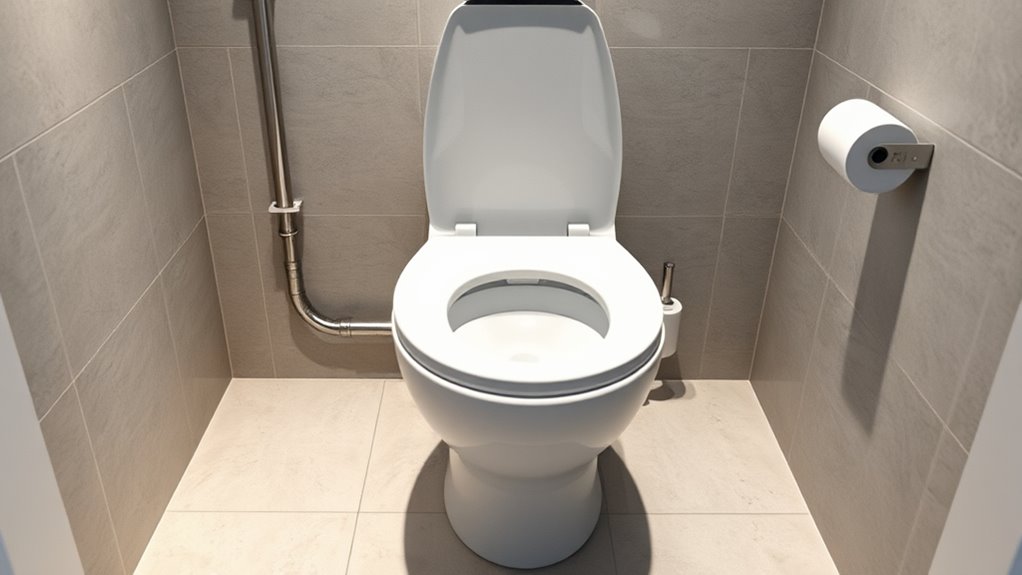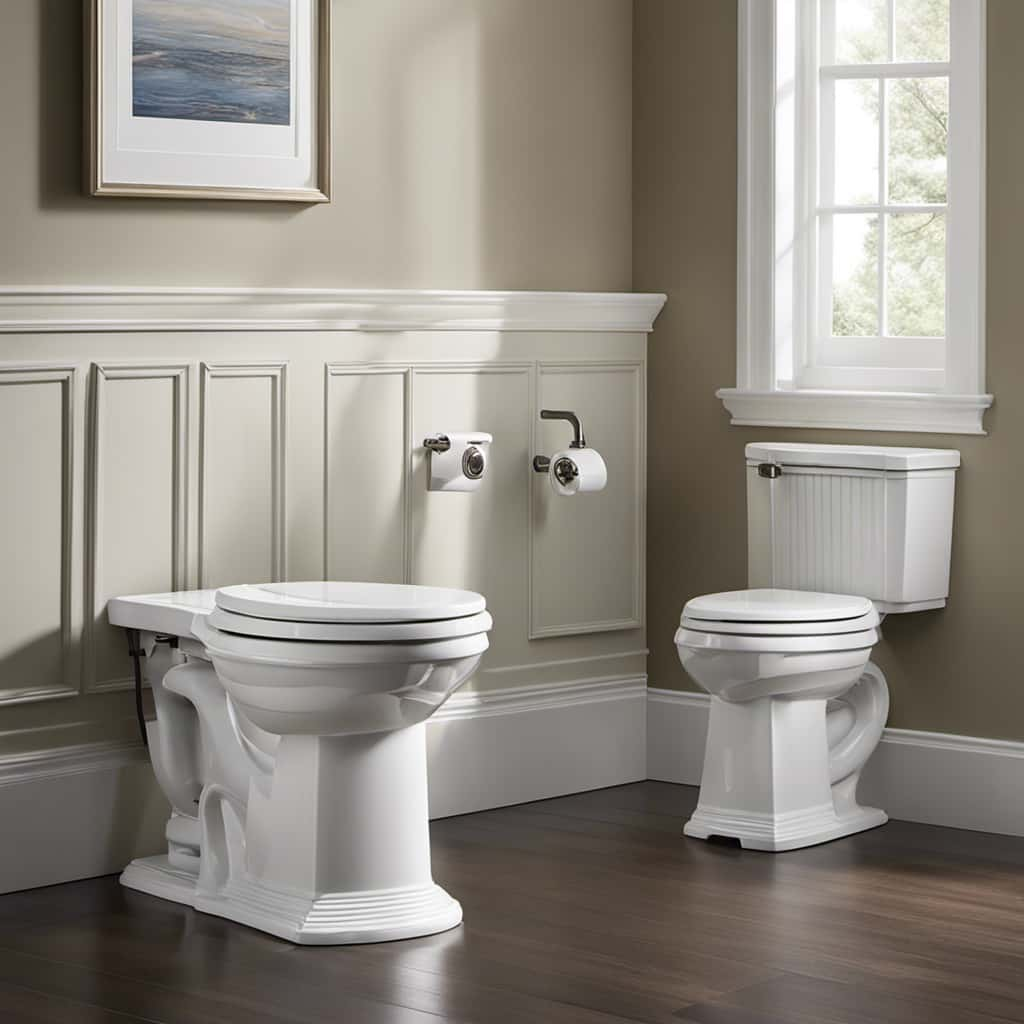Macerating or upflush toilets are a great solution for adding a basement bathroom when traditional plumbing isn’t available. They work by grinding waste into a slurry and pumping it through small pipes, which means you can install them with less disruption. Proper placement, regular maintenance, and high-quality components guarantee smooth operation and durability. If you want to understand how these systems fit your space and ensure long-lasting use, there’s more to discover below.
Key Takeaways
- Macerating toilets grind waste into a slurry for easy pumping through small pipes, ideal for basement bathrooms with limited plumbing options.
- Proper installation involves evaluating space, plumbing compatibility, and ensuring a reliable power supply for smooth operation.
- Regular maintenance includes inspecting for leaks, clearing obstructions, and using approved cleaning agents to ensure durability and performance.
- Installing accessible cleanouts and sealing joints prevent leaks and facilitate easier troubleshooting and upkeep.
- High-quality components ensure long-term reliability, reduce clogs, and extend the lifespan of your upflush toilet system.

Macerating toilets are a practical solution for homes with limited plumbing options or challenging bathroom layouts. If you’re considering installing one in your basement or a space far from your main sewer line, understanding the installation tips and maintenance procedures can make the process smoother and guarantee your toilet functions efficiently for years to come. These toilets work by grinding waste into a slurry using a built-in macerator pump, allowing waste to be pumped vertically through small-diameter pipes, which is especially useful in tight spaces or when traditional plumbing isn’t feasible. The use of high-quality components ensures durability and reliable operation over time.
When it comes to installation tips, start by carefully evaluating your space and plumbing setup. Confirm your existing plumbing can connect to the macerating system, and double-check that your power supply meets the unit’s requirements. Position the toilet in a way that minimizes the length of the discharge pipe—shorter runs reduce strain on the pump and decrease the risk of clogs. Follow the manufacturer’s instructions meticulously, paying close attention to the mounting process and securing all connections tightly to prevent leaks. It’s also wise to install an accessible cleanout or inspection point, which will make future maintenance easier. Properly sealing all joints and ensuring level placement will help prevent leaks and guarantee smooth operation.
Maintenance procedures for macerating toilets are straightforward but require regular attention to keep the system functioning at its best. You should routinely inspect the unit for any signs of leaks or unusual noises, which could indicate a clog or mechanical issue. Clear any debris or buildup around the unit and check that the inlet and outlet pipes are free of obstructions. Use manufacturer-recommended cleaning agents when necessary—avoid harsh chemicals that could damage the pump or blades. Flushing the toilet regularly and avoiding flushing non-degradable items, such as wipes or sanitary products, will also prolong the life of your system. Additionally, some models require periodic lubrication or filter cleaning; consult your user manual for specific maintenance procedures. If you notice persistent problems or unusual odors, it’s best to consult a professional to diagnose and resolve issues before they escalate.
Frequently Asked Questions
How Noisy Are Macerating Toilets During Operation?
You might wonder about the noise levels of macerating toilets during operation. Generally, these toilets produce moderate operating sounds, which are quieter than traditional models but still audible. You’ll notice a consistent hum or whir as the motor runs, but it usually isn’t loud enough to disturb your activities. Proper installation and soundproofing can help minimize the operating sounds further, making them a convenient option for basement bathrooms.
Can Macerating Toilets Handle Feminine Hygiene Products?
You might wonder if macerating toilets can handle feminine hygiene products. Generally, these toilets are designed to be compatible with most waste, but it’s best to check specific toilet compatibility guidelines. Some brands recommend avoiding certain feminine hygiene items, as they can clog the system. To prevent issues, always use appropriate waste and follow manufacturer instructions, ensuring your macerating toilet operates smoothly and remains reliable.
What Is the Typical Lifespan of a Macerating Toilet System?
Your question about the lifespan of a macerating toilet system is vital, as it’s likely to outlast most appliances in your home. Typically, with proper installation and maintenance, these systems last around 10 to 15 years—sometimes even longer. Regular upkeep, like clearing blockages and inspecting parts, guarantees longevity. Think of it as an investment that can serve your basement bathroom needs reliably for over a decade.
Are Macerating Toilets Suitable for Installation in Small or Irregular Spaces?
You’ll find that macerating toilets are ideal for small or irregular spaces thanks to their space flexibility and installation versatility. They don’t require traditional gravity-fed plumbing, so you can install them in tight corners or below-grade areas. This makes them perfect for basement bathrooms or compact areas where standard toilets wouldn’t fit. Their compact design and flexible plumbing options give you more options for creative bathroom layouts.
How Energy-Efficient Are Macerating (Upflush) Toilet Systems?
Oh, the thrill of pondering energy consumption—who knew toilets could be so exciting? Luckily, macerating toilets are surprisingly eco-friendly, using less water and energy than traditional models. They’re designed to be energy-efficient, reducing your carbon footprint while still flushing away your worries. So, if you’re seeking a system that’s both eco-friendly and practical, these upflush toilets deliver on energy efficiency, making your basement bathroom both green and efficient.
Conclusion
Now that you know how macerating (upflush) toilets work, you can see how they transform your basement bathroom experience. They handle waste efficiently, save space, and make installation a breeze. With their powerful motors, quiet operation, and flexible placement, they turn a challenging space into a functional, comfortable retreat. Embrace the simplicity, enjoy the convenience, and imagine the freedom of a basement bathroom that works seamlessly—efficiently, quietly, effortlessly.









